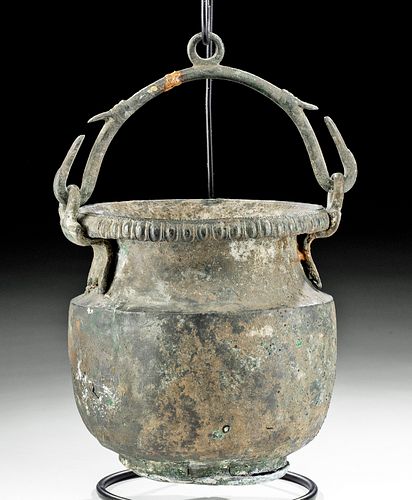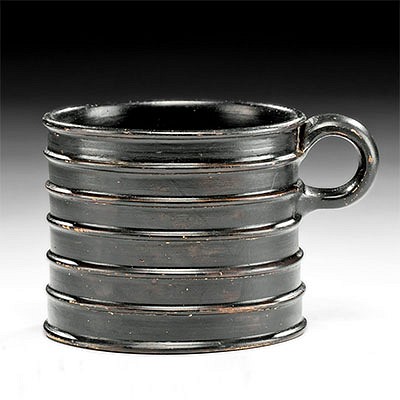Greek Hellenistic Bronze Situla w/ Bale Handle
Lot 28b
About Seller
Artemis Gallery
686 S Taylor Ave, Ste 106
Louisville, CO 80027
United States
Selling antiquities, ancient and ethnographic art online since 1993, Artemis Gallery specializes in Classical Antiquities (Egyptian, Greek, Roman, Near Eastern), Asian, Pre-Columbian, African / Tribal / Oceanographic art. Our extensive inventory includes pottery, stone, metal, wood, glass and textil...Read more
Categories
Estimate:
$1,400 - $2,000
Absentee vs Live bid
Two ways to bid:
- Leave a max absentee bid and the platform will bid on your behalf up to your maximum bid during the live auction.
- Bid live during the auction and your bids will be submitted real-time to the auctioneer.
Bid Increments
| Price | Bid Increment |
|---|---|
| $0 | $25 |
| $300 | $50 |
| $1,000 | $100 |
| $2,000 | $250 |
| $5,000 | $500 |
| $10,000 | $1,000 |
| $20,000 | $2,500 |
| $50,000 | $5,000 |
| $100,000 | $10,000 |
| $200,000 | $20,000 |
About Auction
By Artemis Gallery
Mar 12, 2020
Set Reminder
2020-03-12 10:00:00
2020-03-12 10:00:00
America/New_York
Bidsquare
Bidsquare : Ancient / Ethnographic Around The World
https://www.bidsquare.com/auctions/artemis-gallery/ancient-ethnographic-around-the-world-4957
Ancient art from Egypt, Greece, Italy and the Near East, as well as Asian, Fossils, Pre-Columbian, Native American, African / Tribal / Oceanic, Spanish Colonial, Russian Icons, Fine art, much more! Artemis Gallery info@artemisgallery.com
Ancient art from Egypt, Greece, Italy and the Near East, as well as Asian, Fossils, Pre-Columbian, Native American, African / Tribal / Oceanic, Spanish Colonial, Russian Icons, Fine art, much more! Artemis Gallery info@artemisgallery.com
- Lot Description
Ancient Greece, early Hellenistic Period, ca. 4th to 3rd century BCE. An elegant hammered-bronze vessel known as a situla used for holding funerary offerings or the cremated remains of the deceased. The vessel features a circular body atop a squat foot, a deeply corseted shoulder, a flared rim with a decorative scalloped lip, and a cavernous basin. A pair of claw-footed tabs house integral suspension rings from which hangs an arched bale handle bearing upturned duck head terminals. Mottled layers of brown and green patina have enveloped the vessel and handle. The situla form was originally created for cooling and serving wine at banquets, so this example perhaps once held fruited wine as a burial offering. Size: 6.4" W x 9.2" H (16.3 cm x 23.4 cm); 9.875" H (25.1 cm) on included custom stand.
A stylistically similar example made from silver hammered for GBP 12,500 ($15,955) at Bonhams, London, New Bond Street "Antiquities" auction (October 23, 2013, lot 224).
Provenance: private Orange County, California, USA collection, acquired before 2000
All items legal to buy/sell under U.S. Statute covering cultural patrimony Code 2600, CHAPTER 14, and are guaranteed to be as described or your money back.
A Certificate of Authenticity will accompany all winning bids.
We ship worldwide and handle all shipping in-house for your convenience.
#153681Repair to midsection of bale handle with adhesive residue along break line, and restoration to foot with small losses and adhesive residue along break lines. Bale handle and claw-foot tabs are ancient but likely not original to the vessel; adhesive residue behind tab bodies. Slight bending to overall form of scalloped lip and handle, with abrasions to handle, rim, body, and base, softening to some finer details, and scattered encrustations. Nice earthen deposits and fabulous patina throughout. Old inventory label beneath foot.Condition
- Shipping Info
-
All shipping is handled in-house for your convenience. Your invoice from Artemis Gallery will include shipping calculation instructions. If in doubt, please inquire BEFORE bidding for estimated shipping costs for individual items.
-
- Buyer's Premium



 EUR
EUR CAD
CAD AUD
AUD GBP
GBP MXN
MXN HKD
HKD CNY
CNY MYR
MYR SEK
SEK SGD
SGD CHF
CHF THB
THB
















